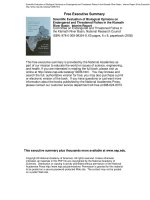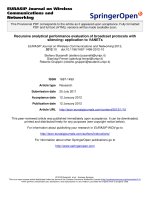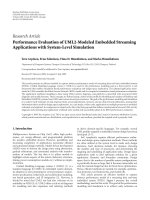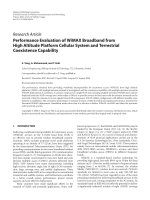Performance evaluation of personalized ventilation personalized exhaust (PV PE) system in air conditioned healthcare settings 9
Bạn đang xem bản rút gọn của tài liệu. Xem và tải ngay bản đầy đủ của tài liệu tại đây (1.84 MB, 7 trang )
Chapter 9: Conclusions and Recommendations
9.1 Review and Achievement of Research Objectives
This study has evaluated the feasibility and performance of a novel PV-PE system in
the protection of a Healthy Person (such as a doctor) and in the ventilation control of
airborne infectious disease induced by exhaled contaminated air from an Infected
Person (such as a patient) in mock-up consultation rooms in healthcare centres.
The three specific objectives of this research and the achievements are reviewed
below:
First Objective
The first objective was to “Evaluate the potential of a PE device to enhance the
performance of a PV device in terms of pulling the PV conditioned outdoor air
towards a Healthy Person”.
The conclusions from the study related to this objective are summarized as follows:
• For the same PV flow rate and manikin location, the personal exposure
effectiveness increased with the increase of the PE airflow rate for most of the
cases. One exception was when PV was supplying fresh air at 10 l/s with a 0.2 m
distance from the manikin. In this scenario, the combined PV-PE did not help with
the pulling effect because the PV could deliver the conditioned outdoor air to the
breathing zone with a high momentum and short distance.
• When the manikin was moved longitudinally along the centerline of PV ATD, the
PV fresh air could still reach the breathing zone. However, when the manikin was
moved in an arc away from the centreline of the PV ATD, the amount of PV air in
the inhaled air dropped quickly to 0.
• After adding the PE device, with both MV and DV conditions, the PE was able to
divert the PV air to some extent. The larger distance and degree were achieved
with DV compared with MV because the relative higher room air velocity with
MV tends to disturb the local environment created by PV-PE. When PE was set at
20 l/s, the effective area could be enlarged to 45 degree for all the cases with DV
and up to 60 degree for a short distance of 0.2 m.
• During a normal consultation process in healthcare centres, where the Infected
Person and the Healthy Person are sitting face to face, the results indicated that the
combined PV and PE for HP could achieve the highest PEE. It was also observed
that the shoulder-PE performed a little better than top-PE in terms of increasing
the PV air in the inhaled air.
• The above-mentioned conclusions imply that when a Healthy Person is working in
a consultation room or a health care setting room, the use of combined PV-PE for
the Healthy Person could provide more fresh air than PV alone, which can
contribute to the infectious control during or after a consultation and check-up
procedure with an Infected Person.
Second Objective
The second objective was to “Determine the effectiveness of airborne infection
control of the combined PV-PE system in conjunction with background MV or
DV systems in terms of the localized extraction of the contaminated exhaled air
from an Infected Person in healthcare settings”. Three scenarios were considered
for this objective, as shown below:
a Infected Person seated facing the seated
Healthy Person
b Infected Person seated under two different
configurations by the side of the seated
Healthy Person
c Healthy Person standing facing the seated
Infected Person
Important conclusions from the study related to this objective areas follows
• In the context of airborne transmission control when the HP and IP are sitting
face to face, the use of PV alone has a potential to protect the HP; the use of
combined PV-PE alone for HP could achieve the lowest Intake Fraction. The
use of PE for IP alone showed much better performance than using PV for HP
alone. However, after activating the PE for IP, the use of PV for HP was
observed to lead to higher or lower exposure. The increase or decrease
depends on the effects of background ventilation type, PE type and PV flow
rates.
• For better airborne transmission control, top-PE is preferred than shoulder-PE
because it could achieve better exposure reduction and lower intake fraction
with a lower flow rate.
• The type of background air was found to have an impact on the flow pattern of
exhaled air. With MV, when PE was not used, the highest exposure possibility
was when the HP and IP are 45 degrees to each other (case B). Case C (HP
and IP are 90 degrees to each other) was found to lead to the lowest exposure
of exhaled contaminated air. With DV, case D (HP standing facing the seated
IP) was observed to result in the highest exposure of the HP while case B
could achieve the best protection for the HP among the three cases when PE
was not switched on.
• After using either shoulder-PE or top-PE, the transmission of exhaled air to
the breathing zone of the HP was largely reduced for cases B to D. The
performance of top-PE was better than that of the shoulder-PE since it
achieves better protection with lower flow rate, thus saving energy and
reducing the noise level.
• For infectious transmission control concerns, both the exposure duration and
the concentration of the infection were found to be critical factors. The longer
the IP stays in the consultation room, the higher is the exposure and the risk
for the HP. By using PE for the IP, the exposure at 30 minutes after entering
the consultation room of the IP was lower than the exposure at 10 minutes
without PE.
Third Objective
The third objective was to “Evaluate the potential for energy savings using the
most optimal PV-PE configuration from objectives1 and 2”
Important conclusions from the study related to this objective areas follows:
With MV, with the increase of flow rate from 4 l/s to 7 l/s, the reduction of IF was
very small. From 7 l/s to 10 l/s, there was a larger drop of iF. With DV, at low flow
rate of PE, the decrease of iF was not obvious from 4 l/s to 6 l/s. A more pronounced
reduction was observed from flow rates of 6 l/s to 7 l/s and 8 l/s to 9 l/s. Compared
with MV, a higher flow rate was required with DV to achieve the same iF. The flow
rate to be applied in the real healthcare settings can be chosen according to the target
of the iF.
9.2 Contributions
This study has developed a novel PV-PE system, which will help in the ventilation
design in consultation rooms in healthcare centres and hospitals to obtain better
infection control as well as a better inhaled air quality. The main findings from the
research are summarised as the key contributions to the body of knowledge:
Hypothesis 1: Combined PV and PE system can enhance the inhaled air quality by
pulling the PV air towards the HP when the HP is moving around his/her desk.
Hypothesis 2: Combined PV and PE system for HP can achieve the highest
Personalized Exposure Effectiveness (PEE).
Hypothesis 3: PV for HP helps to reduce the exposure from IP
Hypothesis 4: PE for IP helps reduce the exposure for HP
4a: Top-PE is better than shoulder-PE
4b: In the presence of PE for IP, DV system leads to a better exposure reduction than
MV system
Hypothesis 5: PE for IP with PV for HP provides the best exposure reduction; PE for
IP is more effective than PV for HP.
Hypothesis 6: With MV, the highest exposure case among the 4 cases studied is when
HP and IP are at 45 degrees to each other, while with DV, the highest exposure is
when HP is standing, facing the seated IP. In the context of airborne infection control
in healthcare settings, this novel PV-PE system is developed to help with the
ventilation design which aims at the protection of a Healthy Person. The exposure to
the exhaled contaminated air of a Healthy Person can be largely reduced with the help
of the PV-PE system. The most significant contributions from this study are in
identifying a suitable design for the PE system and the factors and components
responsible for good infection control in consultation rooms in healthcare centres,
including small clinics and hospitals.
The experimental data and the CFD plots of lower flow rates of PE can lead to a
design guide for HVAC designers/consultants to design the consultation rooms with
respect to infection control. PE flow rate can be selected according to the plots in real
healthcare environments, depending on the target value of the Intake Fraction (iF).
Energy saving implication is evaluated in this study and a few recommendations can
be drawn from this study to save energy.
In addition, the concept of PV-PE system is not only applicable to consultation rooms
in healthcare settings but also to some other potential environment such as offices.
The ability of PE to divert the PV air can be applied in any place with PV installed for
better inhaled air quality. The advantage of PE for infection control can be applied in
any open area with the presence of an Infected Person.
9.3 Limitation of the study
The experiments performed and reported in Chapter 5 were limited to only a few of
the many possible manikin locations and flow rate conditions that would occur in
practice.
The PV and room air temperature were kept at 23 °C through all the experiments.
However, the change of PV air temperature and room air temperature may also affect
the performance of the local environment created by the PV-PE system.
In the CFD study, constant continuous inhalation/exhalation was used for the manikin
instead of cyclic variations in the velocities of respiratory breath. This may lead to a
difference of the results especially for the exhalation case.
The study focuses on normal exhalation process with small diameter of droplets. The
results of this study cannot be applied to larger droplets with different scenarios such
as coughs and sneezes .
Lastly, there is a draft risk (Draft Rating is more than 15%) potential after using the
PE. Further investigation on the users’ acceptability of PE may be interesting.
9.4 Recommendations for Future Work
9.4.1 Recommendation on Scientific Research
Firstly, in the present study, the objective is mainly focussed on the feasibility of the
integrated PV-PE system, driven primarily by experimental work involving objective
measurements. Its practical applicability and user acceptability in real healthcare
settings are recommended for the thermal comfort, draft rating and inhaled air quality
aspects. Further optimisation of the PV-PE system integrated with background
systems (such as MV or DV) in actual healthcare settings and other application areas
would also be possible. Theusers’ preference of different types and locations of PE is
yet another dimension worth exploring. In this study, only MV and DV are examined
in the experiments. For further research, the performance of the novel system in
rooms with other background ventilation systems, i.e. UFAD or downward ventilation
systemcan be evaluated.
In the present study, the indoor temperature level was controlled at 23°C for all
experimental cases. The effect of different room air temperature on the objective
measurement of the transmission of exhaled air and subjective responses when PE is
applied might be worth exploring. The individual control with larger range of PE air
flow rate is another possible dimension to explore.
It is recommended that the performance of the novel PV-PE system should be studied
with the inclusion of more realistic scenarios such as a third person walking in the
immediate vicinity, and changes in the postures of either IP or HP, changes in the skin
temperatures of the IP (eg, IP with fever).
Lastly, further optimisation of energy saving potential of the PV-PE system integrated
with background air conditioning and air distribution systems with full scale energy
measurements is also worth exploring.
9.4.2 Recommendation on Technology Development
The PE outlet mounted either on top or at shoulder level can be further developed that
can slide not only up and down according to a person’s height but also forward or
backward. This may cater for the varying “sitting” posture of an Infected Person.
Moreover, the PE outlet used in this study is some basic round outlet with damper,
through which the air is sucked in a straight line parallel to the axis. Perforated panel
or other designs could be tested. However, the design of the PE outlet needs to be
carefully justified, since it might affect the flow characteristics, suction efficiency and
consequently the contaminant distribution. The results presented in this thesis may not
be directly applicable to a different configuration of the PE outlet.
!









